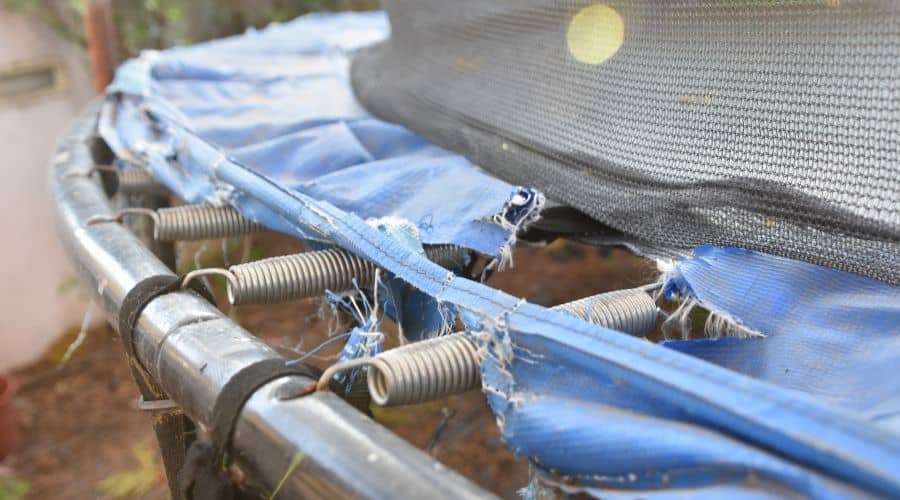Most trampolines have a 1 to 2-year warranty because the parts break down naturally after they’ve been outdoors and used often. The polypropylene mat and net are UV treated, but over time the coating comes off in the sun, wind, and rain, and the plastics photodegrade.
Springs and frames are more durable but still finite and will eventually be subject to rust and corrosion. What is the main reason why trampolines break? Read on, and I will teach you all about trampoline maintenance and longevity so you can jump safely for years to come.
A trampoline frame can collapse, or a screw can come loose causing parts to break, however the main reason why trampolines break is that people don’t maintain and replace the mat in a timely manner. After 2 years, the protective coating sloughs off, and the plastics are exposed to UV, which breaks down the plastics.
Table of Contents
Why Do Trampolines Break
Trampolines break for plenty of reasons, and it’s not just the mat that can wear out over time.
Every part of your trampoline is subject to different wear, tear and pressure as it sits outside and gets bounced on.
I will walk you through the various potential problems with trampolines and explain why they break, plus tell you when to replace or repair parts for longer working life.
The list below is the top 7 reasons why trampolines break:
1 – Why Do My Trampoline Springs Keep Breaking
If your trampoline springs are regularly breaking, you may have gotten a bad batch that was made too brittle. However, that is rare.
Mainly, breaking springs indicate they are worn out from use.
There are two types of common spring problems for trampolines.
First and most frequently, they rust and corrode. Because of the trampoline springs’ shape, it’s impossible to coat them perfectly as they rub against themselves when they flex.
Replacing springs as soon as you see the first sign of damage or corrosion is the easiest way to prevent this.
The second way springs wear out and break is from stretching and flexing. Sure, this is what springs do, but their life is finite.
The harder, faster, and higher you jump, the more they stretch. Additionally, jumping near the edges puts added stress on specific nearby springs.
Always jump alone, in the middle of the mat, and replace any stretched spring where you can see between the coils.
2 – Why Did My Trampoline Mat Rip
Trampoline mats can rip when they are mistreated or overused in one area.
They also have problems if they get scratched hard enough to break some of the fibers in a particular spot.
Fewer intact fibers mean that area has less ability to distribute the pressure and energy from a jump, and cumulative use weakens that part of the trampoline more quickly, causing even more damage.
3 – Too Much Weight
Trampolines have a weight limit. While it’s not the same for all shapes, sizes, and brands, it’s typically enough to hold at least 1 large person.
Most mini trampolines can handle 250 to 330 pounds. Meanwhile, the more giant trampolines can take 330 to over 1000 pounds depending on the company, size, frame, and mat.
Putting too much weight on a trampoline can cause several types of critical failures. The mat and springs can fail under too much pressure.
In extreme cases, the frame may not be able to bear the load and could bend or break.
Resultantly, the best way to prevent damage is to know the limits on your model and not exceed them.
Moreover, while people love to jump together, most trampoline manufacturers strongly suggest only having one jumper at a time to prevent accidents, so it’s easy to stay under the weight limit if you follow that recommendation.
4 – Sharp Objects
The only thing that belongs on a trampoline is a person in bare feet (or with socks).
Never take any sharp objects on your trampoline since it doesn’t take much pressure to cut through the stretched taut mat accidentally.
As Altitude Trampoline Park says, “We recommend wearing comfortable clothes such as shorts, sweats, and t-shirts. We do not allow jumpers to wear any items with sharp objects such as belt buckles or clothing studs.”
Keeping anything sharp off the mats prevents rips, tears, and other injuries.
5 – Sun’s UV Rays
Many parts of a trampoline, such as a mat, spring covers, and net, have plastics in them.
The National Library of Medicine’s National Center for Biotechnology Information explains, “Exposure to ultraviolet (UV) radiation may cause the significant degradation of many materials. UV radiation causes photooxidative degradation which results in breaking of the polymer chains, produces free radical and reduces the molecular weight, causing deterioration of mechanical properties and leading to useless materials, after an unpredictable time.”
In short, parts of your trampoline are plastic, and plastics break down in the sun. It may take years, and a good UV coating will certainly help, but it’s inevitable.
6 – Weather
All-weather affects your trampoline, but heavy wind can be the most damaging. Not only can an unsecured trampoline tip or fly away and become damaged, but the wind is naturally abrasive.
Especially in areas with lots of sand, dust, or ocean air, the particulate matter in the wind will wear away at the metal and other components, leaving them damaged and exposed to other problems like rusting.
If you live in a highly windy area, replacing parts twice as often is a good rule of thumb.
Do a safety inspection once per month or right before you jump, depending on how often you plan to use your trampoline.
7 – Rust
Rust is the enemy of trampolines. The sturdy frames have a rust-resistant coating, but they won’t last forever.
Meanwhile, the large springs can’t be coated entirely because the coils rub together. Even rust-proof metals will eventually become exposed o water and oxygen and begin to rust.
Sadly, rust corrodes the metal. Replace any badly rusted parts immediately.
However, for small rust spots, you can use a rust remover and a temporary sealant like oil to help prolong the life of your trampoline.
Helpful Tips To Know About Why Trampolines Break
Trampolines break whenever a part of them becomes too worn or damaged.
Unfortunately, this can happen in numerous ways, from accidentally cutting the mat with a belt buckle to natural processes like wind and rain.
Here are some helpful tips to know about why trampolines break.
- I recommend checking every part of your trampoline at least once per season, four times yearly. A basic visual safety inspection is usually enough to see if any of your components are worn, corroded, fraying, or in need of repairs or replacements.
- The more you jump, the more wear your trampoline takes, but that’s not the whole story. Being outdoors means the elements will wear your bouncer down anyway, so you shouldn’t hesitate to jump when you want to. After all, that’s what trampolines are made for, and they can take the pressure.
- If you buy a used trampoline, it is essential to check every part during assembly and replace the mat immediately, or after 1 year if it is in good condition when you buy it.
Final Thoughts
An adequately maintained trampoline will need regular replacement parts. Most foam components like the padding on net poles or over the springs need replacing yearly.
It would be best if you replaced plastics like the net and mat every 2 years along with the uncoated springs. The frame may last 5 years or more if the wind isn’t too abrasive.
Remember to put a waterproof cover over it when not in use and check all the components for damage regularly.
You can keep a trampoline for decades if you make timely repairs and replacements.

